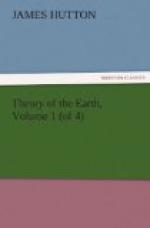It must be evident, that, in the formation of those pendulous bodies, each distinct stalactite must be formed by a separate drop of water; consequently, that no more stalactites can be formed in a given space, than there could have subsisted separate drops of water. Now, a drop of water is a very determined thing; and thus we have a principle by which to judge of those mistaken appearances.
Let us suppose the gut of water to be but one eighth of an inch, although it is a great deal more, we should have no stalactites formed nearer to each other than that measure of space. But those mineral concretions, which are supposed to be stalactical, are contained in half that space, or are nearer to each other than the tenth or twentieth of an inch. I have them like needles, and in every degree of proximity or contiguity, at the same time that they are perfectly solid. Therefore, it is plainly impossible that they could have been formed upon this principle of calcareous stalactite. But, it is only by this false resemblance, that any argument can be formed for the concretion of those bodies from an aqueous solution; in every other respect they are true mineral concretions; and, that these have had a very different origin, has been already the subject of investigation, and will be more particularly examined in the course of this work.
The term infiltration, which has been much employed for explaining mineral appearances, is too vague, imperfect, or unexplicit, for science, whether as the means of knowing nature, or the subject of confutation. This is not the case with that of stalactite; here is a term that implies a certain natural operation, or a most distinct process for attaining a certain end; and we know the principles upon which it proceeds, as well as the several steps that may be traced in the general result. It is an operation which has not only been analysed to its principles; it is also a process which is performed by man, proceeding on his acquired knowledge. Now, were this operation common to the mineral regions, as it is proper to the surface of this earth; we could not remain in any degree of suspense with regard to the origin of those mineral bodies; for, having the true clue of knowledge, we should be able to unravel the most intricate and mysterious appearance. But, so far from this being the case, the more we come to inquire into nature, and employ this principle, the less we find it applicable, and the more involved in darkness is our science.
The places where these false appearances of stalactite are found, are precisely those in which, from the nature of things, all possibility for such an operation is excluded. For, How can this take place within a closs cavity in the mineral regions? The term vegetation may as well be employed for the explanation of those appearances: But what would now be said of such an explication? It is high time that science were properly applied to the natural history of this earth, and mineralists not allowed to impose upon themselves with false reasoning, or to please themselves with the vain attempt of explaining visible effects by unknown causes.




